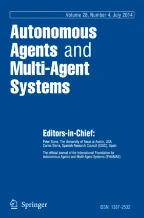Abstract
Increasingly, multi-agent systems are being designed for a variety of complex, dynamic domains. Effective agent interactions in such domains raise some of the most fundamental research challenges for agent-based systems, in teamwork, multi-agent learning and agent modelling. The RoboCup research initiative, particularly the simulation league, has been proposed to pursue such multi-agent research challenges, using the common testbed of simulation soccer. Despite the significant popularity of RoboCup within the research community, general lessons have not often been extracted from participation in RoboCup. This is what we attempt to do here. We have fielded two teams, ISIS97 and ISIS98, in RoboCup competitions. These teams have been in the top four teams in these competitions. We compare the teams, and attempt to analyze and generalize the lessons learned. This analysis reveals several surprises, pointing out lessons for teamwork and for multi-agent learning.
Similar content being viewed by others
Explore related subjects
Discover the latest articles, news and stories from top researchers in related subjects.References
S. Ch'ng and L. Padgham, “Team description: Royal Merlbourne Knights,” in RoboCup-97: The First Robot World Cup Soccer Games and Conferences, Springer-Verlag: Heidelberg, Germany, 1998.
P. R. Cohen, and H. J. Levesque, “Teamwork,” Nous Vol. 35, 1991.
T. Dean, K. Basye, and J. Skewchuk, “Reinforcement learning for planning and control,” in Machine Learning Methods for Planning, Morgan Kaufman: San Francisco, 1993, pp. 67-92.
N. Jennings, “Controlling cooperative problem solving in industrial multi-agent systems using joint intention,” Artif. Intell. Vol. 75, 1995.
H. Kitano, M. Asada, Y. Kuniyoshi, I. Noda, and E. Osawa, “RoboCup: The Robot World Cup Initiative,” Proc. First Int. Conf. Auto. Agents, 1997.
H. Kitano, M. Tambe, P. Stone, S. Coradesci, H. Matsubara, M. Veloso, I. Noda, E. Osawa, and M. Asada, “The RoboCup Synthetic Agents Challenge,” in Proc. Int. Joint Conf. Artif. Intell. (IJCAI), 1997.
S. Luke, C. Hohn, J. Farris, G. Jackson, and J. Hendler, “Co-evolving soccer softbot team coordination with genetic programming,” in RoboCup-97: The First Robot World Cup Soccer Games and Conferences, Springer-Verlag: Heidelberg, Germany, 1998.
S. Mahadevan and J. Connel, “Automatic programming of behavior-based robots using reinforcement learning,” in Proc. Natl. Conf. Am. Assoc. Artif. Intell. (AAAI), 1991.
J. R. Quinlan, C4.5: Programs for Machine Learning, Morgan Kaufmann: San Mateo, CA, 1993.
A. S. Rao, A. Lucas, D. Morley, M. Selvestrel, and G. Murray, “Agent-oriented architecture for air-combat simulation,” Technical Report Technical Note 42, The Australian Artificial Intelligence Institute, 1993.
C. Rich and C. Sidner, “COLLAGEN: when agents collaborate with people,” in Proc. Int. Conf. Auton. Agents (Agents'97), 1997.
P. Stone and M. Veloso, “Task decomposition and dynamic role assignment for real-time strategic teamwork,” in Proc. Int. Workshop on Agent Theories, Architectures and Languages, 1998.
P. Stone, and M. Veloso, “Using decision tree confidence factors for multiagent control,” in RoboCup-97: The First Robot World Cup Soccer Games and Conferences, Springer-Verlag: Heidelberg, Germany, 1998.
R. S. Sutton, “Learning to predict by the methods of temporal differences,” Machine Learning Vol. 3, pp. 9-44, 1988.
M. Tambe, “Towards flexible teamwork,” J. Artif. Intell. Res. (JAIR) Vol. 7, pp. 83-124, 1997.
M. Tambe, W. L. Johnson, R. Jones, F. Koss, J. E. Laird, P. S. Rosenbloom, and K. Schwamb, “Intelligent agents for interactive simulation environments,” AI Mag. Vol. 16, no. 1.
M. Williamson, K. Sycara, and K. Decker, “Executing decision-theoretic plans in multi-agent environment, “ in Proc. AAAI Fall Symp. Plan Execution: Problems and Issues, 1996.
K. Yokota, K. Ozako, A. Matsumoto, T. Fujii, H. Asama, and I. Endo, “Cooperation towards team play,” in RoboCup-97: The First Robot World Cup Soccer Games and Conferences, Springer-Verlag: Heidelberg, Germany, 1998.
Author information
Authors and Affiliations
Rights and permissions
About this article
Cite this article
Marsella, S., Tambe, M., Adibi, J. et al. Experiences Acquired in the Design of RoboCup Teams: A Comparison of Two Fielded Teams. Autonomous Agents and Multi-Agent Systems 4, 115–129 (2001). https://doi.org/10.1023/A:1010027016147
Issue Date:
DOI: https://doi.org/10.1023/A:1010027016147
